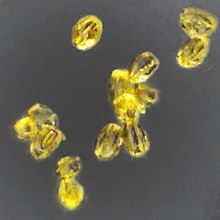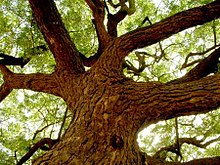Azadirachta indica
| Neem | |
|---|---|

| |
| Flowers and leaves | |
| Scientific classification | |
| Kingdom: | Plantae |
| Clade: | Tracheophytes |
| Clade: | Angiosperms |
| Clade: | Eudicots |
| Clade: | Rosids |
| Order: | Sapindales |
| Family: | Meliaceae |
| Genus: | Azadirachta |
| Species: | A. indica
|
| Binomial name | |
| Azadirachta indica | |
| Synonyms[2] | |
|
List
| |
Azadirachta indica, commonly known as neem, margosa, nimtree or Indian lilac,[3] is a tree in the mahogany family Meliaceae. It is one of two species in the genus Azadirachta. It is native to the Indian subcontinent and to parts of Southeast Asia, but is naturalized and grown around the world in tropical and subtropical areas. Its fruits and seeds are the source of neem oil. Nim is a Hindustani noun derived from Sanskrit nimba (निंब).[4][5][6]
Description
This section needs additional citations for verification. (May 2019) |
Margosa is a fast-growing
White and fragrant
The fruit is a smooth (glabrous), olive-like drupe which varies in shape from elongate oval to nearly roundish, and when ripe is 14–28 mm (1⁄2–1+1⁄8 in) by 10–15 mm (3⁄8–5⁄8 in). The fruit skin (exocarp) is thin and the bitter-sweet pulp (mesocarp) is yellowish-white and very fibrous. The mesocarp is 3–5 mm (1⁄8–1⁄4 in) thick. The white, hard inner shell (endocarp) of the fruit encloses one, rarely two, or three, elongated seeds (kernels) having a brown seed coat.

The margosa tree[8] is similar in appearance to its relative, the chinaberry or bakain, Melia azedarach,[9] with which it may be confused. Melia azedarach also has toothed leaflets and similar looking fruit. One difference is that margosa leaves are pinnate but chinaberry leaves are twice- and thrice-pinnate.
Taxonomy
The name Azadirachta indica was first published by Adrien-Henri de Jussieu in 1830.[10] In 1753, Carl Linnaeus had described two species, Melia azedarach and Melia azadirachta.[11] De Jussieu considered Melia azadirachta to be sufficiently different from Melia azedarach to be placed in a new genus.[12] For both his species, Linnaeus referred to the name 'azedarach',[11] which is derived from the French 'azédarac', which in turn is from the Persian 'āzād dirakht' (ازادرخت), meaning 'free or noble tree'.[13] The Persian name of the tree, azad darakhat-e-hind, meaning 'the free tree of India, implies that it is free from disease and insect problems.[14]
Distribution
Azadirachta indica is considered to be native to the Indian region and Bangladesh in the Indian subcontinent and to Cambodia, Laos, Myanmar, Thailand and Vietnam in Indochina. It has been widely introduced elsewhere in tropical and subtropical regions, from South America to Indonesia.[2]
Ecology
The margosa tree is noted for its
Weed status
Margosa is considered as a weed in many areas, including some parts of the Middle East, most of Sub-Saharan Africa including West Africa and Indian Ocean states, and some parts of Australia. Ecologically, it survives well in similar environments to its own, but its weed potential has not been fully assessed.[15]
In April 2015, A. indica was declared a class B and C weed in the Northern Territory, Australia, meaning its growth and spread must be controlled and plants or propagules are not allowed to be brought into the NT. It is illegal to buy, sell, or transport the plants or seeds. Its declaration as a weed came in response to its invasion of waterways in the "Top End" of the territory.[16]
After being introduced into Australia, possibly in the 1940s, A. indica was originally planted in the Northern Territory to provide shade for cattle. Trial plantations were established between the 1960s and 1980s in Darwin, Queensland, and Western Australia, but the Australian margosa industry did not prove viable. The tree has now spread into the savanna, particularly around waterways, and naturalised populations exist in several areas.[17]
Phytochemicals
Margosa fruit, seeds, leaves, stems, and bark contain diverse phytochemicals, some of which were first discovered in azadirachta seed extracts, such as azadirachtin established in the 1960s as an insect antifeedant, growth disruptor, and insecticide.[18][19] The yield of azadirachtin from crushing 2 kg of seeds is about 5 g.[18]
In addition to azadirachtin and related
Uses





Margosa leaves are dried in India and placed in cupboards to prevent insects eating the clothes, and also in tins where
Culinary
The tender shoots and flowers of the margosa tree are eaten as a vegetable in India. A soup-like dish called vēppam pū cāṟu (வேப்பம் பூ சாறு) in
Margosa is used in parts of mainland
Traditional medicine
Products made from margosa trees have been used in the traditional medicine of India for centuries,[19][18] for treating skin troubles and rheumatism,[21] but there is insufficient clinical evidence to indicate any benefits of using margosa for medicinal purposes.[18] In adults, no specific doses have been established, and short-term use of margosa appears to be safe, while long-term use may harm the kidneys or liver; in small children, margosa oil is toxic and can lead to death.[18] Margosa may also cause miscarriages, infertility, and low blood sugar.[18]
In Southern India and the Middle-East, neem twigs are often used as a teeth-cleaning twig.[citation needed]
Pest and disease control
Margosa is a key ingredient in
Margosa oil has been shown to avert termite attack as an ecofriendly and economical agent.[23]
Margosa oil for polymeric resins
Applications of margosa oil in the preparation of polymeric resins have been documented in recent reports. The synthesis of various alkyd resins from margosa oil is reported using a monoglyceride (MG) route and their utilization for the preparation of PU coatings.[24] The alkyds are prepared from reaction of conventional divalent acid materials like phthalic and maleic anhydrides with MG of margosa oil.
Other uses
- Tree: the margosa tree is of great importance for its
- Fertilizer: neem extract is added to fertilizers (urea) as a nitrification inhibitor.[27]
- Animal feed: margosa leaves can be occasionally used as forage for ruminants and rabbits.[28]
- Teeth cleaning: margosa has traditionally been used as a type of teeth-cleaning twig.[29]
Toxicity
According to the
Claimed effectiveness against COVID-19
In March 2020, claims were circulated on social media in various Southeast Asian countries and Africa, supporting the use of margosa leaves to treat COVID-19. The Malaysian Ministry of Health summarized myths related to using the leaves to treat COVID-19, and warned of health risks from over-consumption of the leaves.[31]
Genome and transcriptomes
Margosa genome and
Cultural and social impact

The name
In 1995, the European Patent Office (EPO) granted a patent on an anti-fungal product derived from margosa to the United States Department of Agriculture and W. R. Grace and Company.[37] The Indian government challenged the patent when it was granted, claiming that the process for which the patent had been granted had been in use in India for more than 2,000 years. In 2000, the EPO ruled in India's favour, but W. R. Grace appealed, claiming that prior art about the product had never been published. On 8 March 2005, that appeal was lost and the EPO revoked the Neem patent.[37]
Biotechnology
The biopesticide produced by extraction from the tree seeds contains
Gallery
-
Flowers
-
Unripe fruit
-
Neem tree in a banana farm in India
-
Neem tree farm
-
Twigs for sale
-
Fruit drying for oil extraction
-
Cleaning teeth by chewing stick
-
Native of Chhattisgarh with Neem branches and leaves for Hareli Festival
-
A tree inGambia
-
A tree in Bangladesh
See also
- Azadirachtin
- Ayurveda
- Arid Forest Research Institute (AFRI)
- Neem cake
- Neem oil
- Babool (brand) of toothpaste
- Teeth cleaning twig(datun)
References
- . Retrieved 19 November 2021.
- ^ a b c "Azadirachta indica A.Juss". Plants of the World Online. Board of Trustees of the Royal Botanic Gardens, Kew. 2017. Retrieved 19 November 2020.
- ^ "Azadirachta indica". Germplasm Resources Information Network. Agricultural Research Service, United States Department of Agriculture. Retrieved 9 June 2017.
- ^ Compact Oxford English Dictionary (2013), Neem, page 679, Third Edition 2008 reprinted with corrections 2013, Oxford University Press.
- A. C. Burnell (1996), Hobson-Jobson, Neem, page 622, The Anglo-Indian Dictionary, Wordsworth Reference. (This work was first published in 1886)
- ^ Encarta World English Dictionary (1999), Neem, page 1210, St. Martin's Press, New York.
- ^ "Neem | Azadirachta indica". Plants For A Future. Retrieved 25 October 2023.
- ^ saikia, Curtingle (2 January 2023). "How to Use Neem- Uses and benefits - prakasti.com". Prakasti. Retrieved 11 January 2023.
- ^ The Tree. National Academies Press (US). 1992.
- ^ "Azadirachta indica A.Juss." The International Plant Names Index. Retrieved 26 March 2023.
- ^ a b Linnaeus, C. (1753), "Melia", Species Plantarum, vol. 1, Stockholm: Laurentius Salvius, pp. 384–385, retrieved 26 March 2023
- ^ de Jussieu, A. (1830). "Mémoire sur le groupe des Méliacées". Mémoires du Muséum d'histoire naturelle. 19: 153–304. Retrieved 26 March 2023. p. 221
- ^ "azedarach". Merriam-Webster Dictionary. Retrieved 26 March 2023.
- ISBN 9788189866006.
- ^ Plant Risk Assessment, Neem Tree, Azadirachta indica (PDF). Biosecurity Queensland. 2008. Retrieved 24 January 2014.
- ^ Neem has been declared: what you need to know (PDF), Department of Land Resource Management, 2015, archived from the original (PDF) on 24 March 2015, retrieved 17 March 2015
- ^ Neem Azadirachta indica (PDF), Department of Land Resource Management, 2015, archived from the original (PDF) on 24 March 2015, retrieved 17 March 2015
- ^ a b c d e f g h i j "Neem". Drugs.com. 13 August 2020. Retrieved 21 September 2020.
- ^ a b c Anna Horsbrugh Porter (17 April 2006). "Neem: India's tree of life". BBC News.
- ^ "Nimbolide". PubChem, US National Library of Medicine. 6 March 2021. Retrieved 10 March 2021.
- ^ Tejesvi, M.V.; Tamhankar, S.A.; Kini, K.R; Rao, V.S.; Prakash, H.S. (2009). "Phylogenetic analysis of endophytic Pestalotiopsis species from ethnopharmaceutically important medicinal trees". Fungal Diversity. 38: 167–183.
- ^ "Neem Cake Fertilizer, Uses, Application, Benefits | Agri Farming". www.agrifarming.in. 9 August 2020.
- ^ YashRoy, R.C.; Gupta, P.K. (2000). "Neem-seed oil inhibits growth of termite surface-tunnels". Indian Journal of Toxicology. 7 (1): 49–50.
- S2CID 96641587.
- .
- ^ Puhan, Sukumar, et al. "Mahua (Madhuca indica) seed oil: a source of renewable energy in India." (2005).
- ISBN 978-3527306732
- FAO. Last updated on 2 October 2015
- ^ "Different Strokes for Different Folks: A History of the Toothbrush – Page 4 – Virtual Dental Museum". dentalmuseum.pacific.edu. Retrieved 8 July 2021.
- PMID 20448012.
- ^ "Neem turmeric in treatment of COVID-19" (PDF). 1 April 2020. Retrieved 5 November 2020.
- ^ Krishnan, N; Swetansu Pattnaik; S. A. Deepak; et al. (25 December 2011). "De novo sequencing and assembly of Azadirachta indica fruit transcriptome" (PDF). Current Science. 101 (12): 1553–1561.
- PMID 22958331.
- PMID 27172223.
- S2CID 16605633.
- S2CID 11857916.
- ^ a b "India wins landmark patent battle". BBC News. 9 March 2005. Retrieved 2 October 2009.
- PMID 12568548.
- S2CID 85845199.
- S2CID 36781838.
- S2CID 35506559.
- S2CID 207357717.
External links
- National Research Council (US) Panel on Neem (1992). Neem: A Tree For Solving Global Problems. National Research Council (US) Panel on Neem.
- Invasiveness information from Pacific Island Ecosystems at Risk (PIER)
- Neem information from the Hawaiian Ecosystems at Risk project (HEAR)
- ISBN 978-0-7234-3410-8. Archived from the originalon 29 December 2010. Retrieved 15 January 2011. Contains a detailed monograph on Azadirachta indica (Neem; Nimba) as well as a discussion of health benefits and usage in clinical practice.











